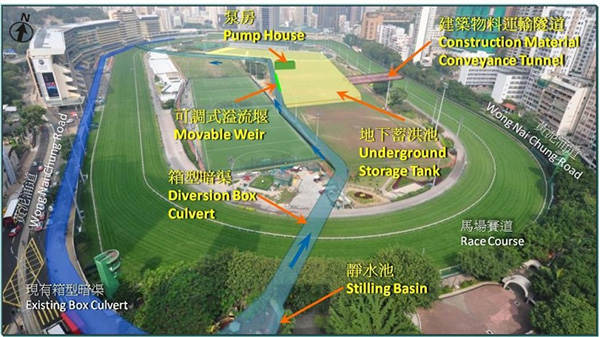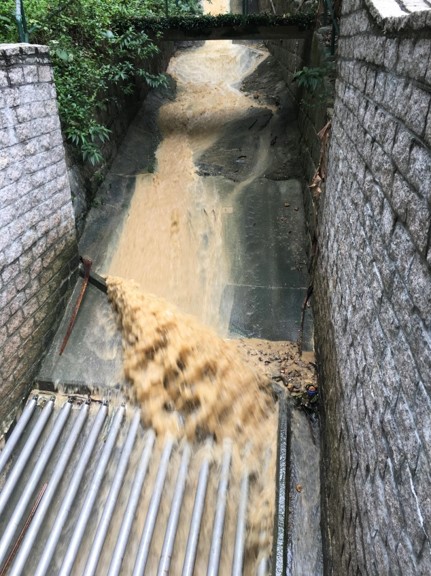Happy Valley is a
low‐lying urban area located in the hinterland of the Wan
Chai District and is surrounded by a hilly terrain.
Serious flooding occurred in the Happy Valley catchment,
in particular the Happy Valley Recreation Ground (HVRG),
Hong Kong Jockey Club racecourse and nearby streets,
during heavy rainstorms in 2000, 2006 and 2008. To address
the flooding problem, Happy Valley Underground Stormwater
Storage Scheme (HVUSSS) at the HVRG is constructed. The
scheme would raise the flood protection level of the
drainage system in Happy Valley to cater for rainstorms
with a return period of 1 in 50 years, and in turn
significantly reduce the risk of flooding in Happy Valley
and areas in the vicinity.
The HVUSSS greatly enhanced
the flood protection level of the city and solved the
flooding problems in Happy Valley and Wan Chai districts.
The adoption of an innovative underground spillway energy
dissipation and flow conveyance design, a system of smart
and automatic movable weirs with real time control, water
harvesting system and green building designs have created
a more resilient and adaptable drainage system that blends
harmoniously with the environment. It has been awarded the
2018 Dai Yu Science & Technology Medal of Chinese
Hydraulic Engineering Society (“中國水利學會「大禹水利科學技術獎」”) for
the outstanding achievements of the HVUSSS in the area of
innovations and technology development.



In the early 2000s,
the Drainage Services Department proposed an
innovative “upstream interception” scheme, namely The
Hong Kong West Drainage Tunnel (HKWDT) to improve the
flood protection standard for areas around Causeway
Bay, Admiralty, Central and Sheung Wan.
The engineering challenge was
how to effectively intercept and transfer the
supercritical (high speed) flow from the steep natural
watercourses located in the densely‐populated
Mid‐Levels district to the drainage tunnel located
some 100 m below ground. The breakthrough was the
development of a compact bottom rack and vortex intake
system to stably decelerate the supercritical flow,
with efficient energy dissipation, for smooth
conveyance of flow from higher elevations to the deep
drainage tunnel and discharge to the sea.
Since commissioning of the
HKWDT in 2012, the vortex intake system has been put
to the test on many severe rainfall occasions, and
successfully protected the downhill urban areas of
Hong Kong Island from flooding. This system has set a
global standard for reference and the new vortex
intake design method has been adopted in many critical
hydraulic infrastructure designs internationally.
The supercritical vortex
intakes for the Hong Kong West Drainage Tunnel (HKWDT)
won the First Prize of Construction Sustainability in
Construction Innovation Award 2017 of the Hong Kong
Construction Industry Council (CIC).
Smart Urban Water
Supply Systems field testing facility, the first of
its kind in Hong Kong and Greater China, is
constructed at the Beacon Hill Intermediate Level
Freshwater Reservoir in Kowloon Tong, next to Lung
Cheung Road. The facility was designed and developed
by HKUST with the support of the Hong Kong Water
Supplies Department. This unique facility provides an
opportunity to test in‐pipe wave propagation with a
degree of realism not possible with laboratory
experiments without interference to the normal supply
of water to the public. A 250 m long pipeline network
of 150 mm HDPE pipe has been constructed along the
periphery of the site (covering a footprint of around
65 m x 65 m). The water supply is fed from the Beacon
Hill reservoir at around 60 m of head; the flow is
monitored by an electromagnetic flow meter, and the
upstream pressure can be set with a Pressure Reducing
Valve (PRV). A valve designed for rapid closure is
installed at the downstream end of the system.
Pressure transducers, branches and leaks can be
installed at selected nodes. The facility permits
field‐scale experiments on advanced, transient‐based,
diagnostic methods for leakage/fault detection and
pipeline wall condition assessment.
